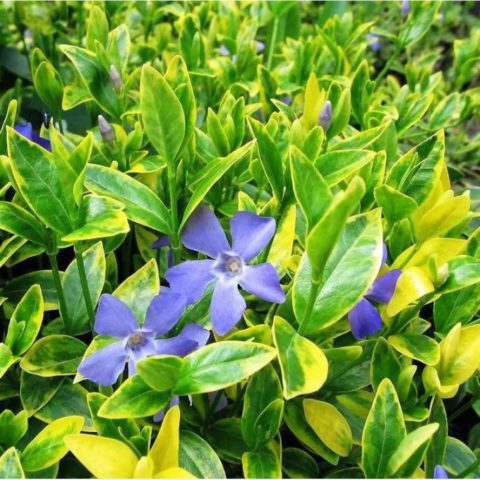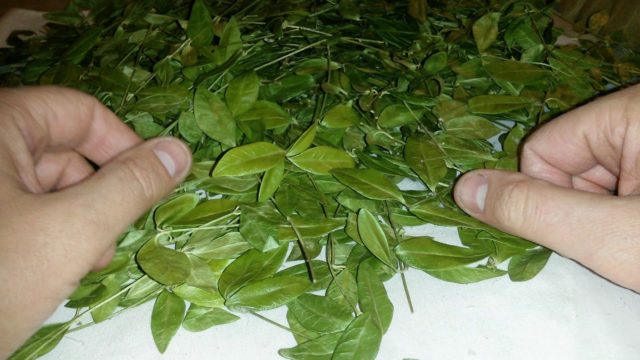Content
Photos and descriptions of the small periwinkle can be found with equal success both in a gardener's reference book and in a medical encyclopedia. This medicinal plant has been successfully used in folk medicine for several centuries, and even traditional science has recognized the positive results of its use.
Description
Lesser periwinkle (Vinca minor) belongs to the Kutov family. This herbaceous plant today can be found in almost every corner of the planet, although it prefers temperate climate zones. However, the high adaptability of the small periwinkle allows it to be successfully cultivated both in the southern and northern regions.
This variety is classified as a shrub-type perennial. Lesser periwinkle has a spreading crown and two types of shoots (primary and secondary). The main stems are flowering. Both are covered with thin greenish-red bark. The leaf blades (3-5 cm) are elliptical in shape and have a leathery structure.The outer side of the leaf is bright green, the lower part is greenish-gray.

Periwinkle is most often used as a ground cover crop.
The root system of the plant is powerful. It is located in the upper layers of the soil and can grow to an area of 0.7-0.9 m². The height of the small periwinkle varies from 20 to 40 cm and depends on the habitat. The variety blooms from late April to August (depending on the species) with small azure-colored flowers not exceeding 2.5-3 cm in diameter. At the end of the flowering period, the small periwinkle forms an oblong fruit filled with seeds.
Chemical composition
Microscopy of Vinca minor made it possible not only to become more familiar with the structure of the plant, but also to analyze its chemical composition.
Studies have shown that it contains more than 50 alkaloids - organic compounds actively used in medicine. Among them are vinblastine and leurosine, which are used in folk medicine as antitumor agents.
Lesser periwinkle also includes:
- ursolic acid;
- carotene;
- tannins;
- flavonoids;
- vitamin P;
- calcium;
- zinc;
- iron;
- potassium.
Pharmacological properties
Lesser periwinkle (Vinca minor) has a sedative, vasodilator and antimicrobial effect. Drugs based on it can stop bleeding, lower blood pressure and have a calming effect.
The alkaloids Devincan and Vincamine, which are part of Vinca minor, have a positive effect on cerebral circulation. Based on the plant, drugs are made for neurogenic tachycardia and lymphogranulomatosis.
Varieties
Despite the fact that there are only 12 varieties of small periwinkle in the wild, breeders have managed to develop many decorative varieties of this crop. Modern gardens delight the eye with periwinkle flowers in a variety of shades: from white to purple.
Atropurpurea
Lesser periwinkle "Atropurpurea" is distinguished by the presence of purple colors and two blooms: in May-June and in August-September. A plant no more than 30 cm high can occupy an area of up to 1 m². The ovoid leaves differ in length from wild species. Their size reaches 4-4.5 cm.
The young bush of the small periwinkle has low frost resistance, and therefore requires mandatory shelter for the winter. The optimal site for planting the variety is a place with slight partial shade. Planting in open sun may require frequent watering.

The culture looks organic both on lawns and in hanging containers
Aureovariegata
Lesser periwinkle "Aureovariegata" is an amazingly beautiful decorative species with soft lilac flowers with a diameter of no more than 2.5 cm. Another difference from the classic varieties is the leaves. In this variety they are soft and light green with a yellowish edge.
The “Aureovariegata” variety is distinguished by its high resistance to low temperatures. It requires shelter only in the absence of snow, and then only in order to preserve the bright shade of green mass.

The variety "Aureovariegata" feels great both in the shade and in the open sun.
Alba
Lesser periwinkle "Alba" is a creeping shrub with milky-white small inflorescences and elongated leaves (up to 5 cm). Abundant flowering of the variety can be observed in May-June. The rest of the time it takes on the appearance of a “green carpet”.
Despite the fact that the variety can grow in the sun, it exhibits more luxuriant flowering in shaded areas. Designers use this plant most often as a ground cover crop.

Periwinkle "Alba" is often planted in rockeries
Illumination
Periwinkle minor "Illumination" is one of the few golden-variegated varieties of periwinkles. It is a groundcover shrub with lavender flowers and golden foliage edged with green. The variety is distinguished by its unpretentiousness. It can grow even in very dark areas, so it is often used as a decorative carpet for fences and in tree trunks.
The Illumination variety tolerates drought well, as it is able to draw moisture from any type of soil. This species is often planted next to dwarf conifers.

The Illumination variety is often used as a means of protection against erosion and weed growth.
Plena
One of the most beautiful varieties of small periwinkle is “Plena”. Its main advantage is its spectacular double flowers of a violet-blue palette, reaching 3 cm in diameter. The “Plena” variety blooms actively in April-May, passively from June to September.
Like most other types of small periwinkle, this variety is distinguished by frost resistance (up to -30 ° C) and unpretentiousness. However, the culture does not like heavily shaded areas, preferring sun or partial shade.

Periwinkle "Plena" looks great in hanging arrangements
Blue and Gold
“Blue and Gold” is distinguished by an unusually variegated leaf color, which, in combination with shades of flowers, allows you to create a beautiful grassy covering on the site.
The variety is unpretentious, like all other species, however, for better flowering it requires a little more light or at least diffuse lighting.Tolerates frost, does not require shelter, and is excellent for central and central regions.

Variety "Blue and Gold" - an excellent ground cover, often used in landscape design
Medicinal properties
Lesser periwinkle has a whole range of medicinal properties. It is actively used for migraines, dizziness and sudden jumps in blood pressure. The alkaloid Devincan has a hypotensive effect by reducing vascular tone, therefore preparations based on Vinca minor extract are used in the treatment of cerebral vessels.
Extracts and decoctions from this plant are recommended for toothache; lotions from it are often used for skin diseases. Substances contained in Vinca minor stimulate regeneration and have a strong anti-inflammatory effect.
Application in medicine
Pharmacognosy of Vinca minor goes back hundreds of years. It has been actively used since ancient medical practice. Doctors often prescribed it to their patients for fever, malaria and skin diseases (rash, eczema, itching). Microelements present in Vinca minor promote blood clotting, so decoctions, infusions and lotions from this plant are recommended for various types of bleeding (uterine, nasal, pulmonary).
An alkaloid called “rosevin” is used in medicine in the treatment of tumor diseases (lymphogranulomatosis, hematosarcoma, myeloma). Vinkapan, like Devincan (alkaloids), has a vasodilator and mild sedative effect. An extract from Vinca minor Atropurpurea improves the condition of capillaries and has a positive effect on diseases such as impotence and sexual weakness.
Folk recipes
In common parlance, the lesser periwinkle is called burial grass, green grass and hornbeam. Infusions and decoctions are prepared from it, which are actively used in traditional medicine.

Dried periwinkle can be purchased at any pharmacy.
Infusion
Infusions from this herb are indispensable for high blood pressure, as well as intestinal bleeding and tuberculosis.
In order to prepare the herbal infusion, you need to pour 4 g of dry small leaves with 200 ml of boiling water and heat the resulting mixture in a water bath for 20 minutes. After which the infusion can be cooled, strained and taken 3 times a day, 60-70 ml before meals.
Decoction
Decoctions from the small periwinkle variety are recommended for infertility. They are used as a rinse for toothache, periodontal disease and bad breath. Lotions with a decoction are used to disinfect wounds and ulcers.
To prepare the decoction, you need to pour 4 g of dry leaves of the small periwinkle into 250 ml of clean water, bring to a boil and, after keeping it on the fire for 1 minute, turn it off. Infuse the decoction for 25-30 minutes, then filter and consume 20 ml 3 times a day before each meal.
Tincture
An alcohol tincture from a plant of this variety is most often used as a treatment for impotence.
Place dry leaves, stems and flowers of Vinca minor in a 0.5 liter glass jar. Pour vodka into a container one-third full, close the lid tightly and leave in a warm place for 9 days. The main condition is the absence of light. Before use, the alcohol tincture must be strained.
Take the tincture before meals 2 times a day at the rate of 7 drops per 50 ml of clean water.
Procurement and storage of raw materials
In traditional and folk medicine, the leaves of the Vinca minor variety are most often used. However, flowers with leaves are often used. The above-ground part of the plant is carefully cut off, dried and placed in containers or canvas bags. Store harvested raw materials for no more than two years.
During the collection process, care must be taken, since the small periwinkle variety is a poisonous crop.

The leaves of the plant are mainly harvested
Contraindications
Lesser periwinkle is not recommended for use without first consulting a doctor. Its overdose can lead to problems in the functioning of the cardiovascular system, including cardiac arrest.
Also contraindications to the use of plants of this variety are:
- bradycardia;
- pregnancy;
- breastfeeding period;
- children (up to 12 years) and old age;
- heart pathologies.
An incorrectly selected dosage will negatively affect the functioning of the kidneys, liver and nervous system.
Conclusion
Photos and descriptions of the small periwinkle can be found in any botanical reference book. An inconspicuous plant, which is often used as a green covering, has enormous benefits, since its correct use can cope with small wounds and alleviate the progression of serious diseases such as leukemia.
Reviews
Gardeners value the small periwinkle for its unpretentiousness. Its varieties and types allow you to recreate any fantasy and idea in the garden.








